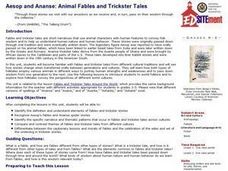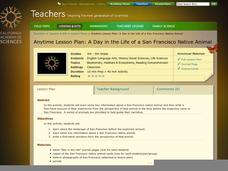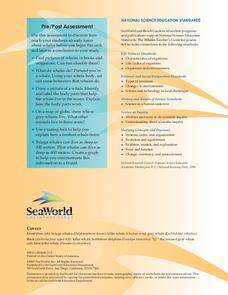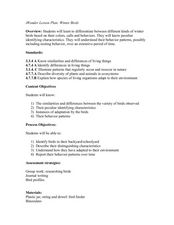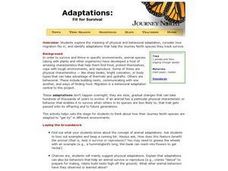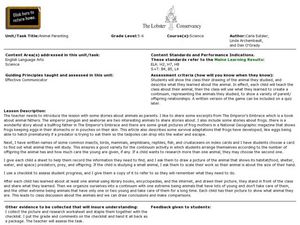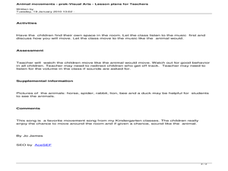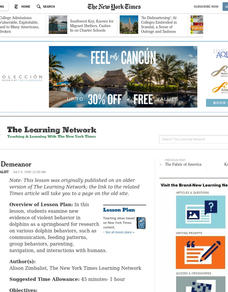Curated OER
Aesop and Ananse: Animal Fables and Trickster Tales
Students complete compare and contrast activities dealing with fables and trickster tales to determine how each uses animals to portray human characteristics, specifically strengths and weaknesses, as well as pass wisdom from one...
American Museum of Natural History
What's the Big Deal About Paleontology?
Paleontologists could be considered detectives of the past. A quick online lesson describes the science of paleontology and the importance of fossils. Young scientists read about how paleontologists analyze the features of fossils to...
California Academy of Science
A Day inthe Life of a San Francisco Native Animal
Although the lesson is specifically about the San Francisco Bay area, it's good enough to be adapted to any local region. Children research what the landscape in San Francisco was like prior to settlement, they consider the types of...
PBS
Star Power
Let there be light—or maybe not. Pupils learn about light pollution with an investigation of constellations. They create constellation boxes and experiment with different levels of light. Observations are then made about the lighting in...
Sea World
Whales
A whale of a lesson is sure to intrigue your elementary oceanographers! Learn about the mammals of the sea with a series of activities about whales, dolphins, and porpoises. Kids complete worksheets about the anatomy of a whale, create a...
Polar Trec
Plankton Parents
Plankton are so abundant in the ocean they outweigh all of the animals in the sea. In this three day activity, groups discuss and become familiar with plankton, capture females, and look for egg production on day three.
Serendip
Evolution of Fur Color in Mice – Mutation, Environment and Natural Selection
Most species of animals include a variety of fur or hair color, but why? Scholars watch a video about a changing environment for mice. As the rocks around them change hues, different colors of mice begin to thrive. Discussion questions...
Curated OER
iWonder Lesson Plan: Winter Birds
Students report on the colors, calls, behaviors, and physical characteristics of different winter birds. In this winter birds lesson plan, students also make a bird feeder.
Curated OER
Adaptations: Fit For Survival
Middle schoolers track species using the Journey North project. They examine the meaning of physical and behavioral adaptation, migration, and identify adaptations that help the species they track survive.
Curated OER
Animal Parenting
Students analyze parenting instincts. In this parenting instincts lesson, students view a drawing of animal they studies and describe what they learned about the animal. Students teach the class about their animal and the class creates a...
Curated OER
Infusing Equity by Gender into the Classroom
Students discover the biases between the two genders by comparing males and females in different species. For this gender identity lesson, students research National Geographic Magazine and view videos demonstrating the differences...
Curated OER
Structural and Behavioral Adaptations
Students participate in a role playing lab that allows students to experience how different beak adaptations play a role in the type of food the animal can eat, therefore playing a role in the survival of the species.
Curated OER
Mapping Animal Behavior
Young scholars discuss the value of sampling in science. They, in groups, map cricket movement in response to various stimuli and graph their results.
Curated OER
Pets: Oh Behave
They say that a dog is a man's best friend. Why is that? Discuss with your class why people like pets and the responsibilities with owning one. They read an article about pet behavior and write a short essay comparing one of their...
Curated OER
Adapting to Animal Behavior for Survival
Second graders explore animal behaviors and adaptations by researching several different animals and their habitats.
Curated OER
Barnyard Bingo
Learners explore farm animal sounds. They sing a song that introduces them to the sounds of farm animals. Students create animal bingo cards to help them recognize the correct sounds for each of the farm animals. They discuss the types...
Curated OER
Animal Movements
Students discuss the behavior of different animals and how they move. They explore the ways that this helps them live and find food in their environment. They participate in a game that requires them to mimic the ways in which animals move.
Curated OER
4-H Cat Activity Page
As part of a unit on animals, this would be an interesting activity for upper elementary and middle school students. The 40 question activity could be linked to a research activity on animals or pets.
Curated OER
Orca United Nations
Students study the differences between sets of data and explain how organisms are adapted to their environment. In this marine mammals lesson students analyze data based on set criteria.
Curated OER
Animal Movements
Students become familiar with the movement of various animals. In this animal movement lesson, students relate their knowledge of animal movements to the music they are moving to.
Curated OER
Creating and Restoring Health Forests
Students explore how to create and restore healthy forests. Given a scenario, teams of students create a management plan to assist the forest in becoming healthy, safe, and appealing. Students consider the ecosystem, adaptations of the...
Curated OER
Dolphin Demeanor
Young scholars examine new evidence of violent behavior in dolphins as a springboard for research on various dolphin behaviors, such as communication, feeding patterns, group behaviors, parenting, navigation, and interactions with humans.
Curated OER
Massive Migrations
Here is an exciting exploration of a fascinating topic for your emerging ecologists: bird migration! They begin by visiting the US Fish & Wildlife Service website to discover which Arctic birds come to their areas. They are assigned...
Curated OER
Hatching Chickens
Students consider the concept that much can be learned from the natural world by observation. They observe the incubation and hatching of chicken eggs in the classroom and discuss the needs of living things.


